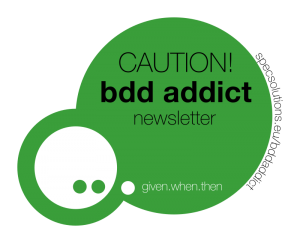Dear BDD Addicts,
 Welcome to the second BDD Addict newsletter. My plan is to collect interesting posts, articles and events about behavior driven development, SpecFlow, Cucumber moreover also test automation and agile testing. I’m following many channels, but surely not all. So if you have seen something that fed your addiction, just send me the link with a few comments to bddaddict@specsolutions.eu.
Welcome to the second BDD Addict newsletter. My plan is to collect interesting posts, articles and events about behavior driven development, SpecFlow, Cucumber moreover also test automation and agile testing. I’m following many channels, but surely not all. So if you have seen something that fed your addiction, just send me the link with a few comments to bddaddict@specsolutions.eu.
How do you know that you are already a BDD addict? I don’t know, but google assistant recently started to advertise me the rates for DB Base Metals Double Long (currently at $4.52)… do you also have that? Yeah, this is BDD at The New York Stock Exchange (Arca)…
So while waiting for BDD to prosper, your dose for March 2016 contains the following topics:
- [Watch] TDD – Eat it raw! (Kevlin Henney)
- [Background] Why Cucumber? (Aslak Hellesøy)
- [Learn:SpecFlow] How to structure test automation code with the driver pattern (David Leitner)
- [Learn:SpecFlow] Feature file backgrounds (Gaspar Nagy)
- [Process] Given/When/Then — How to phrase them? (Liz Keogh)
- [Process] Climbing up and down inside the Test Pyramid (Konstantin Kudryashov, Mathias Verraes)
- [Event] Agilia Conference 2016
Read the full newsletter…
Subscribe to it at http://specsolutions.eu/bddaddict so that you never miss it! (Did you get the February issue?)
